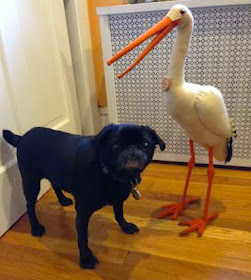Steiffgal can't think of a better way to start your day - and this review - than with this delightful and unusual Steiff rooster on wheels. He has amazing wheel-appeal! According to the catalog in part, "This wonderful wooden rooster pull toy is made from three pieces of carefully cut wood. The bird itself is delightfully and authentically painted in greens, tans, and golds. He has black dimensional eyes and a playful red comb and waddle. He is mounted upon a metal carriage with four green eccentric wheels. He also sways back and forth in a see-saw manner; the overall effect of him in motion is simply charming. Rooster retains his Steiff button, which is skillfully placed near where his ears would be, if he had any. Rooster appeared in the Steiff line from 1919-1941 in this size only. SIZE: Overall 7-1/2″ h."
Although most people associate soft toys and collectibles with Steiff, the company also has a long tradition of manufacturing wooden playthings, too. The first wooden items appeared around 1910 and were mostly accessories for the Teddy bears, animals, and dolls in the line. Then in the late 19-teens and early 1920's, Steiff began producing large numbers of wooden items - in part because high quality woolen fabrics were in short supply post World War l. These treasures included block sets, wooden characters on rocking bases and wooden wheels, building sets, trains, pull wagons, animal-themed wagons, novelties, and animals and birds on wheels. The pull toy birds were exceptionally popular and manufactured overall through the early 1940's. A wooden duck squeaker toy from this period is pictured here on the left for comparison; the photo is from the website www.oldwoodtoys.com.
Next, let's all shake a leg and check out this fantastic Steiff sweetheart from the late 1920's. According to the catalog in part, "This “tall drink of water” is Rabbiette. She has a mohair rabbit head; long, soft unjointed dangling limbs; and mohair hands and paws. Her body, arms, and legs are made from velvet, which has faded over time. She has glass, very large black and brown pupil eyes and embroidered claws, nose, and mouth. Rabbiette is one of a series of long limbed lovelies in the Steiff catalog from 1927-1932. These “play and car dolls” included Bulliette, the bulldog, and Fluffiette, the cat, among others. These were based on the most popular named Steiff characters of the time. Each had the head of the character, mohair paws and feet, and dangling velvet limbs. Rabbiette has all of her Steiff IDs including her most exceptional metal rimmed chest tag, long trailing F button, and red ear tag. SIZE: 8″ h."
Doesn't Rabbiette just make you feel like dancing? Here's why! Some toy historians liken this Steiff pattern to a very popular product group from the Chad Valley Toy Company of
England called "Tango Toys." It is suspected that Steiff modified this toy design to fit their
popular characters and manufacturing processes of the time. They then named and launched their line as "Charleston
Animals" based on the Charleston dance crazy of the 1920’s, with its
fast moving arm and leg movements. Rabbiette was designed as a novelty for fun and play, so it is absolutely amazing that this one survived in such good condition with all of her IDs! Rabbiette's Charleston "cousin" Bulliette is pictured here on the left for comparison, the photo is from Christies.
Today's third and final Julia's highlight certainly deserves a salute! Here we have a great example of Steiff’s early five ways jointed
military-themed dolls. According to the catalog in part... "Except for his boots and accessories, he is made
entirely from felt... His center seamed face is detailed with
tiny black shoebutton eyes, pink rosy cheeks, and a brown painted
mustache, eyebrows, and nostrils. His hair is indicated by brown
airbrushing on his sideburn areas and the back of his head. Soldier’s
uniform consists of a matching top coat, hat, and pants... Soldier has oilcloth shoes, a large white leather
belt, and a ceremonial sabre. The doll retains his tiny trailing F style
button as his Steiff ID. Steiff made many similar styled soldiers; this
one is most likely “Dragoon” who was manufactured in 28 and 35 cm from
1909-1918 overall. SIZE: 11″ h."
These great early Steiff felt dolls captured the attention of the world upon their introduction, and remain collector's favorites over a century later. It is interesting to note that elements of this soldier's design really span two important doll-making phases at Steiff. His black button eyes and somewhat more prominent nose and ears are relatively common characteristics of Steiff's earliest felt dolls which were introduced in 1903. However, his overall realistic body proportions (including to-scale feet), lifelike expression, and perfectly scaled accessories are more typical to Steiff's dolls produced in the roughly 1910 through late 1920's time frame. This soldier doll is a great example of Steiff's legendary turn of last century craftsmanship and attention to detail - just check out the work on his hat and uniform! And his leather belt and sabre truly put him in a class by himself from the collector's standpoint.
Steiffgal
hopes this preview of some of great Steiff treasures to be auctioned off at the upcoming James
D. Julia's November 2014 toy auction has you going once, going twice, going three times to check out their entire online catalog... which can be accessed by clicking here.
Have a question about one of your Steiff treasures? Let's talk! Click here to learn more.
Have a question about one of your Steiff treasures? Let's talk! Click here to learn more.



















